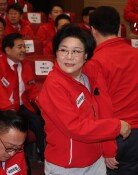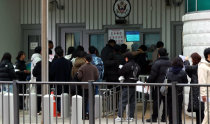Controversy over F-35 tech transfer amid pitiful military diplomacy
Controversy over F-35 tech transfer amid pitiful military diplomacy
Posted September. 25, 2015 09:46,
On the U.S. refusal to allow transfer of core technologies to Korea in connection with Koreas purchase of the F-35 as the nations next-generation fighter jet fleet, Rep. Kim Jeong-hoon, head of the ruling Saenuri Partys policy committee, said on Wednesday, I hope that this serves as an opportunity for Korea check the way it deals with the U.S. As controversy flared up during parliamentary inspection of the government over the issue, in which the Korean military sought to receive transfer of core technologies while introducing 40 F-35 fighter jets from Lockheed Martin but the U.S. refused, Kim criticized the government in a rare move as a member of the ruling party. "Lockheed Martin reportedly signed the contract under the condition the U.S. government approves at the time of contract signing, but I wonder if our government exerted any efforts toward the U.S. government to make the deal actually happen," Kim said.
According to materials that the Defense Acquisition Program Administration (DAPA) submitted to the National Assembly recently, the U.S. denied transfer of four technologies including Active Electronically Scanned Array (AESA) radar, infrared ray tracking equipment that the Seoul government demanded. DAPA said these technologies were not included in the official contract, but if Korea does not receive core technologies, chances are high that the Korean Fighter Experimental (KFX) will become an empty project. Even when Korea Aerospace Industries was picked as the contractor of the KFX in March, some pointed out that Getting transfer of core technologies from Lockheed Martin by winning U.S. government approval is the key, but the project is poised to fail even before starting.
The chance for Korea to acquire core technologies was low in the first place, because the U.S. has never provided such core technologies to other countries such as Japan. For this reason, Lockheed Martin included the condition if the U.S. government approves in the memorandum of agreement for negotiated trade. Despite this, DAPA only pledged to push for the KFX using technologies from the U.S. even without specifically identifying the technologies that it will take over from the U.S., and now the agency claims that transfer of such technologies was not part of the original contract, which sounds derisive to the people. The U.S. might not have violated the contract, but the Korean military is largely to blame as it has failed to acquire technology that it needed despite the claims that the Korea-U.S. alliance is the strongest ever and watertight, and behaved as if such technology transfer is possible despite knowing well such limitations.
A total of 7.3418 trillion won (6.149 billion dollars), which Korea is to spend to procure F-35 fleet, is an astronomical amount of money to the country. The government should re-examine how much efforts it has exerted in military diplomacy to persuade Washington to strengthen Koreas defense capacity with its limited budget. It is pity that the public naively believed that transfer of core technologies would be possible if Korea persuades the U.S. by banking on the strongest Korea-U.S. alliance, a claim that foreign affairs minister Yun Byeong-se has repeatedly made. At the Korea-U.S. summit between President Park Geun-hye and U.S. President Barack Obama on October 16, President Park will need to hold in-depth discussions about ways for Korea to introduce weapons at more favorable conditions as a core ally. If Korea cannot afford to diversify suppliers of its weapons to include Europe and other countries due to the need to ensure seamless joint operation of military capabilities between Korea and the U.S., Korea should at least dispel the misunderstanding that Seoul is an easy target in the U.S. efforts to secure national interests.





![화장실 갇혔을 때 생존법…“최후에는 변기뚜껑” [알쓸톡]](https://dimg.donga.com/c/138/175/90/1/wps/NEWS/IMAGE/2025/12/26/133042007.3.png)

